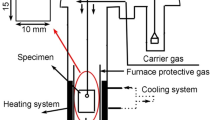Abstract
A method to reduce the scale of silicon-containing steels by adjusting the heating route has been proposed in the present study. The influence of heating rate on the oxidizing behavior of steels containing Si was studied by simultaneous thermal analyzer with various heating rates under the condition of the fixed heating time and same heating temperature. The heating process was divided into two sections, i.e., fast heating stage and slow-heating stage. Three kinds of heating route with different end temperatures at fast heating stage and different heating rates at slow-heating stage were designed. Additionally, the solidification process of Fe2SiO4 at different cooling rates was observed by in situ observation. The results showed that the amount of Fe2SiO4 and oxidation mass gain both decreased with the decrease of end temperature at fast-heating stage. Likewise, the net-like distribution of Fe2SiO4 became less apparent with the decrease of end temperature at fast-heating stage and the increase of the heating rate at slow-heating stage. Therefore, it would be beneficial for descaling with a heating route of a lower end heating temperature at the fast-heating stage and a higher heating rate at slow-heating stage. Besides, the solidifying point of Fe2SiO4 decreased apparently at a higher cooling rate.









Similar content being viewed by others
References
Hu H J, Xu G, Wang L, Xue Z L, Zhang Y L, and Liu G H, Mater Des 5 (2015) 95.
Zhou M X, Xu G, Hu H J, Yuan Q, and Tian J Y, Metals 7 (2017) 8.
Liu X J, Cao G M, He Y Q, Jia T, and Liu Z Y, J Iron Steel Res Int 20 (2013) 73.
Yang Y L, Yang C H, Lin S N, Chen C H, and Tsai W T, Mater Chem Phys 112 (2008) 566.
Cao G M, Liu X J, Sun B, and Liu Z Y, J Iron Steel Res Int 21 (2014) 335.
Kusabiraki K, Watanabe R, and Ikehata T, ISIJ Int 47 (2007) 1329.
Suarez L, Schneider J, and Houbaert Y, Defect Diffus Forum 273–276 (2008) 661.
Okada H, Fukagawa T, and Ishihara H, ISIJ Int 35 (1995) 886.
Fukagawa T, Okada H, and Maeharara Y, ISIJ Int 34 (1994) 906.
Taniguchi S, Yamamoto K, Megumi D, and Shibata T, Mater Sci Eng A 308 (2001) 250.
Li S J, Liu Y B, Zhang W, Sun Q S, and Wang L P, J. Iron Steel Res Int 27 (2015) 55 (in Chinese).
Yang C H, Lin S N, and Chen C H, Oxid Met 72 (2009) 145.
Abuluwefa H, Guthrie R I L, and Ajersch F, Oxid Met 46 (1996) 423.
Chen R Y, and Yuen W Y D, Oxid Met 59 (2003) 433.
Yuan Q, Xu G, Zhou M X, He B, and Hu H J, Metals 2 (2017) 37.
Yuan Q, Xu G, Zhou M X, and He B, Metals 6 (2016) 94.
Yuan Q, Xu G, Zhou M X, and He B, Int J Miner Metall Mater 23 (2016) 1.
Logani R, and Smeltzer W W, Oxid Met 1 (1969) 3.
Garnaud G, and Rapp R A, Oxid Met 11 (1977)193.
Wagner C, Z Phys Chem 21 (1933) 25.
He B, Xu G, Zhou M X, and Yuan Q, Metals 6 (2016) 137.
Acknowledgements
The authors gratefully acknowledge the financial support from the National Natural Science Foundation of China (NSFC) (No. 51274154); The Major Projects of Technology Innovation of Hubei Province (2017000011). The National Nature Science Foundation of China (No. 51704217), Special Fund of Wuhan University of science and Technology for Master Student’s short-term studying abroad.
Author information
Authors and Affiliations
Corresponding author
Rights and permissions
About this article
Cite this article
Yuan, Q., Xu, G., He, B. et al. A Method to Reduce the Oxide Scale of Silicon-Containing Steels by Adjusting the Heating Route. Trans Indian Inst Met 71, 677–684 (2018). https://doi.org/10.1007/s12666-017-1200-0
Received:
Accepted:
Published:
Issue Date:
DOI: https://doi.org/10.1007/s12666-017-1200-0




